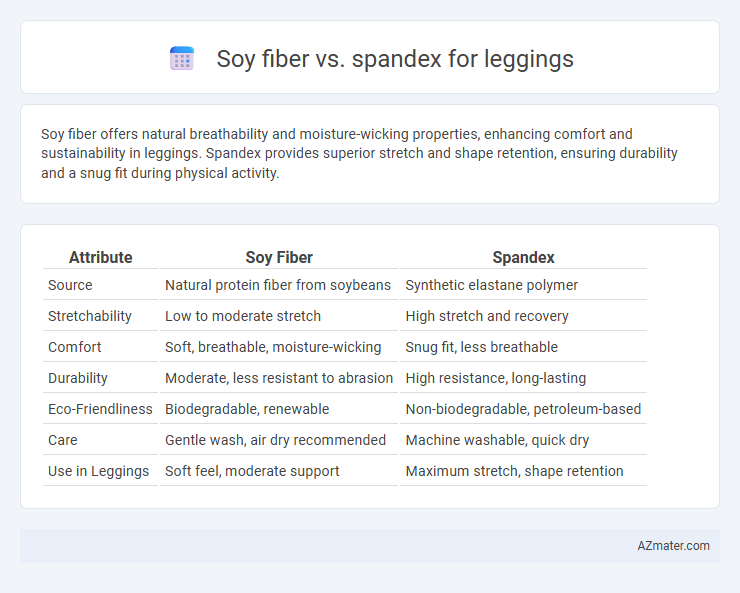Soy fiber offers natural breathability and moisture-wicking properties, enhancing comfort and sustainability in leggings. Spandex provides superior stretch and shape retention, ensuring durability and a snug fit during physical activity.
Table of Comparison
| Attribute | Soy Fiber | Spandex |
|---|---|---|
| Source | Natural protein fiber from soybeans | Synthetic elastane polymer |
| Stretchability | Low to moderate stretch | High stretch and recovery |
| Comfort | Soft, breathable, moisture-wicking | Snug fit, less breathable |
| Durability | Moderate, less resistant to abrasion | High resistance, long-lasting |
| Eco-Friendliness | Biodegradable, renewable | Non-biodegradable, petroleum-based |
| Care | Gentle wash, air dry recommended | Machine washable, quick dry |
| Use in Leggings | Soft feel, moderate support | Maximum stretch, shape retention |
Introduction to Legging Fabric Choices
Legging fabric choices significantly impact comfort, durability, and performance, with soy fiber and spandex among the popular materials. Soy fiber, derived from soybean protein, offers natural breathability and moisture-wicking properties, making it eco-friendly and soft against the skin. Spandex provides superior stretch and shape retention, enhancing flexibility and support during physical activities.
What is Soy Fiber?
Soy fiber is a natural textile derived from soybean protein, known for its soft, breathable, and eco-friendly properties, making it an excellent alternative to synthetic fibers in leggings. Unlike spandex, which is a synthetic elastane fiber providing exceptional stretch and shape retention, soy fiber offers moisture-wicking and antibacterial benefits while maintaining comfort and sustainability. Combining soy fiber with small amounts of spandex enhances flexibility and durability in activewear leggings.
What is Spandex?
Spandex is a synthetic fiber known for its exceptional elasticity, commonly used in leggings to provide a snug fit and enhance movement flexibility. Unlike soy fiber, which is a natural, biodegradable fabric offering breathability and softness, spandex delivers superior stretch and shape retention, making it ideal for activewear. Its durability and resistance to perspiration make spandex a preferred choice for performance leggings.
Comparison: Texture and Feel
Soy fiber leggings offer a soft, silk-like texture with natural breathability and moisture-wicking properties, providing a comfortable and smooth feel against the skin. Spandex leggings, known for their high elasticity and stretch, deliver a snug, supportive fit with a sleek and smooth surface that contours to body movements. While soy fiber emphasizes softness and natural comfort, spandex prioritizes flexibility and form-fitting compression for active wear.
Breathability and Moisture Management
Soy fiber leggings offer superior breathability due to the natural fibers' porous structure, allowing better air circulation and keeping the skin cool during workouts. In contrast, spandex provides excellent moisture management by quickly wicking sweat away from the body, though it tends to have less breathability and can retain heat. Combining soy fiber's ventilation properties with spandex's stretch and moisture-wicking capabilities creates leggings that optimize both comfort and performance.
Stretch and Flexibility
Soy fiber leggings offer moderate stretch with natural elasticity derived from soybean protein, promoting breathability and softness but less dynamic flexibility compared to synthetic fibers. Spandex, known for its exceptional 400-800% stretch capacity, delivers superior flexibility and shape retention, making it the top choice for high-performance leggings requiring maximum stretch and recovery. Combining soy fiber with spandex in blends enhances comfort and sustainable properties while ensuring optimal stretch for active wear and yoga leggings.
Durability and Longevity
Soy fiber leggings offer moderate durability with natural resistance to wear, but they are more prone to pilling and stretching over time compared to synthetic fibers. Spandex, known for its exceptional elasticity and recovery, provides superior longevity by maintaining shape and resisting sagging even after extensive use. Choosing spandex blends in leggings ensures enhanced durability and prolonged wear, making them ideal for high-performance and everyday activities.
Eco-Friendliness and Sustainability
Soy fiber leggings offer superior eco-friendliness due to their biodegradable nature and renewable source derived from soybean processing byproducts. In contrast, spandex, a synthetic material made from non-renewable petroleum-based resources, contributes to microplastic pollution and has a longer decomposition period. Choosing soy fiber supports sustainable fashion by reducing reliance on fossil fuels and promoting lower environmental impact during production and disposal.
Skin Sensitivity and Comfort
Soy fiber leggings offer superior skin sensitivity benefits due to their natural, hypoallergenic properties, making them ideal for individuals with sensitive or allergy-prone skin. Spandex provides exceptional stretch and shape retention but may cause irritation for some wearers due to its synthetic and less breathable nature. Combining soy fiber with spandex blends the comfort of soft, moisture-wicking fabric with the flexibility needed for activewear, enhancing overall comfort and skin health.
Which is Better for Leggings: Soy Fiber or Spandex?
Soy fiber leggings offer superior breathability and eco-friendly advantages due to their natural origin and moisture-wicking properties, making them ideal for sensitive skin. In contrast, spandex provides unmatched elasticity and shape retention, ensuring leggings maintain a snug fit during intense workouts and daily wear. Choosing between soy fiber and spandex depends on prioritizing sustainability and comfort versus stretchability and durability in leggings.

Infographic: Soy fiber vs Spandex for Legging
 azmater.com
azmater.com